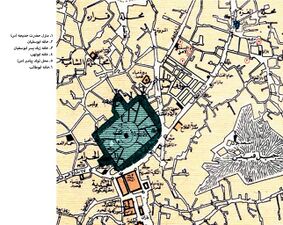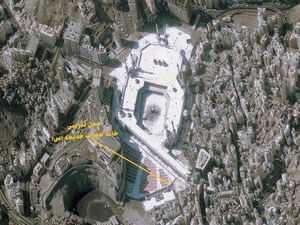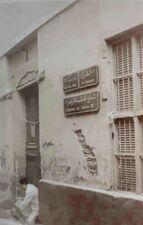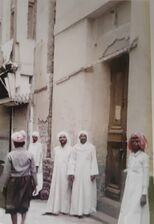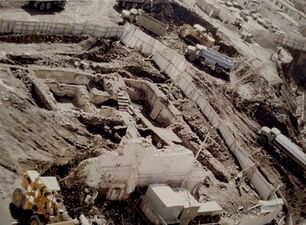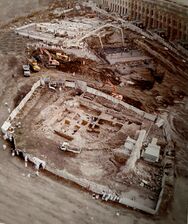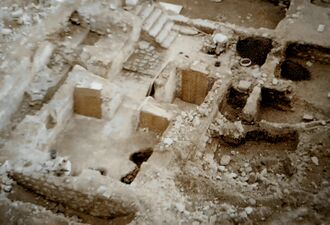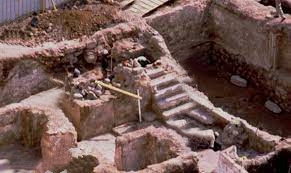Lady Khadija's House: Difference between revisions
Pourghorbani (talk | contribs) |
Pourghorbani (talk | contribs) |
||
| Line 17: | Line 17: | ||
==The first descriptions of Khadīja’s house== | ==The first descriptions of Khadīja’s house== | ||
According to ʿAbu l-walīd Azraqī, a historian of the third century, this house was taken over by [[ʿAqīl b. Abī Ṭālib]] after the Prophet’s migration to [[Medina]]. [[Muʿāwīyah b. Abī Sufyān]] bought that house and turned it into a mosque and opened a door to it from his father Abū Sufyān’s house.<ref>Azraqī, ''Akhbār Makka'', vol. 2, p. 199; Ibn Zahīra, ''al-Jāmiʿ al-laṭīf'', p. 286; Kurdī,''al-Tārīkh al-qawīm'', vol. 1, p. 289.</ref> This house was later called Dār | According to ʿAbu l-walīd Azraqī, a historian of the third century, this house was taken over by [[ʿAqīl b. Abī Ṭālib]] after the Prophet’s migration to [[Medina]]. [[Muʿāwīyah b. Abī Sufyān]] bought that house and turned it into a mosque and opened a door to it from his father Abū Sufyān’s house.<ref>Azraqī, ''Akhbār Makka'', vol. 2, p. 199; Ibn Zahīra, ''al-Jāmiʿ al-laṭīf'', p. 286; Kurdī,''al-Tārīkh al-qawīm'', vol. 1, p. 289.</ref> This house was later called Dār Abī Sufyān<ref>Kurdī,''al-Tārīkh al-qawīm'', vol. 1, p. 289.</ref>Elsewhere, Azraqī says that the house was occupied by Mu'tab, the son of [[Abu Lahab]] and the Prophet's cousin, one of the staunch enemies of the Prophet after the migration of the Prophet <ref>Ibn Saʿd,''al-Ṭabaqāt al-kubrā'' | ||
vol. 4, p. 45.</ref> and the Prophet did not claim the house after the [[conquest of Mecca]].<ref>Azraqī, ''Akhbār Makka'', vol. 2, p. 245.</ref> | vol. 4, p. 45.</ref> and the Prophet did not claim the house after the [[conquest of Mecca]].<ref>Azraqī, ''Akhbār Makka'', vol. 2, p. 245.</ref> | ||
Ibn Jubir (d. 614 AH) mentioned this house in his travelogue at the end of the 6th century. This house had two domes at that time. One is a larger dome called the Dome of the Revelation, which was the place where the Prophet and Khadīja had lived, and the place where Gabriel descended on the Prophet, and the other is a small dome, where [[Lady Fatima]] | Ibn Jubir (d. 614 AH) mentioned this house in his travelogue at the end of the 6th century. This house had two domes at that time. One is a larger dome called the Dome of the Revelation, which was the place where the Prophet and Khadīja had lived, and the place where Gabriel descended on the Prophet, and the other is a small dome, where [[Lady Fatima]] was born.<ref>Ibn Jubayr, ''Safarnāma Ibn Jubayr'', p. 81-82.</ref> | ||
==Khadīja’s house in the 9th century== | ==Khadīja’s house in the 9th century== | ||
Revision as of 22:27, 28 August 2023
The House of Lady Khadīja,(Arabic:دار السیده الخدیجه;Dār al-sayyida al-khadīja ) the Prophet’s wife, in Mecca, was the house where the Prophet of Islam (pbuh) lived after marrying Lady Khadīja until he migrated to Medina. This house was the birthplace of Lady Fatima(s) and other children of Khadīja(s) and many Meccan verses of the Quran were also revealed to the Prophet in that house and also Khadīja died in this house. Since the 6th century, this place has been known in sources as the birthplace of Lady Fatima, the daughter of the Prophet. Since then, there were two domes in this house. One was called Qubba al-Waḥy and it was built on a room that was considered the place of worship and the place where Gabriel descended on the Prophet. The other dome was built over a room that was said to be the birthplace of worship of lady Fatima(s).
In the 14thAH/20th century AD, after House of Saʿūd conquered Mecca, this house was destroyed and later a building for teaching the Quran was built in its place. During the demolition and excavation of this place with the aim of developing the Grand Mosque in 1410 AH/1989 AD, the remains of the old building of Khadija’s house were found under the soil. This place has disappeared today and its location is in the area of Masjid al-Ḥarām.
location
Lady Khadīja’s house was in Mecca[1]and it was located in the vicinity of Abū Sufyān's house. [2]
This house was the place where the Prophet lived with Lady Khadīja[3] and many Meccan verses of the Qurʾan were revealed in this house.[4]Lady Fatima and other children of Khadīja were born in this house.[5] It is also reported that this house is the place of demise of Khadija and the Prophet lived in this house after that until he migrated to Medina.[6]
Names
This house became known as the Dār (house) of Lady Khadīja because of the residence of her and it was also known as the birthplace of Lady Fatima(s) because of the birth of lady Fatimah.[7]
The first descriptions of Khadīja’s house
According to ʿAbu l-walīd Azraqī, a historian of the third century, this house was taken over by ʿAqīl b. Abī Ṭālib after the Prophet’s migration to Medina. Muʿāwīyah b. Abī Sufyān bought that house and turned it into a mosque and opened a door to it from his father Abū Sufyān’s house.[8] This house was later called Dār Abī Sufyān[9]Elsewhere, Azraqī says that the house was occupied by Mu'tab, the son of Abu Lahab and the Prophet's cousin, one of the staunch enemies of the Prophet after the migration of the Prophet [10] and the Prophet did not claim the house after the conquest of Mecca.[11]
Ibn Jubir (d. 614 AH) mentioned this house in his travelogue at the end of the 6th century. This house had two domes at that time. One is a larger dome called the Dome of the Revelation, which was the place where the Prophet and Khadīja had lived, and the place where Gabriel descended on the Prophet, and the other is a small dome, where Lady Fatima was born.[12]
Khadīja’s house in the 9th century
Taqī al-Dīn Fāsī (d. 832 AH), the historian of Mecca, gave a detailed description of the building of Khadīja’s house, or according to him “the birthplace of Fatima, and pointed out that this house is considered virtuous by the people and they visit it.[13]
fāsī says this place is more like a mosque because it has a portico with seven arches and eight columns. In the middle of the front wall there are three altars and in front of it is a portico with four arches and five columns. And between these two porches is a courtyard. The other part of the house includes rooms. One is the birthplace of Fatima, the other is the Qubba al-Waḥy, and the third is the Mukhtabā.[14] Some believe that these rooms are the same old area of the house that was in the time of the Prophet and the mosque was added to it later.[15] The shorter descriptions of other writers are also consistent with fāsī,’s description until the eleventh decade.[16]
Khadīja’s house in the 13th and 14th century
In a travelogue from the end of the period of Nāṣir al-Dīn Shah Qājār (R. 1313-1264 AH), it is mentioned in the description of the house of Lady Khadīja(s) that it had a marble floor, a dome was on the birthplace of Lady Fatima(s) and a room in it called the place of worship of the Prophet(pbuh) had been famous.[17]According to a report in 1265 A.H, in the place of Khadīja's house, a Takiyyah known as "Takiyyah al-Sayyida Fatima" was built for the use of the poor.[18]
Destruction of the house
The Egyptian writer Muḥammad Ḥusayn Haykal (d.1376 AH) visited the place of this house in 1354 AH. He writes: Wahhabis have destroyed the birthplace of lady Fatima(s) and now this place is an empty space and there is no trace of it. [19] . Muḥammad Luṭfī Jumʿa also confirmed the destruction of the house in his travelogue.[20]
The construction of a Quranic school in the place of the house
In Jamādī al-Awwal 1370 AH, a building was built as a school for the memorization of the Holy Quran on the ground of lady Khadīja’s house.[21] Muḥammad Ṭāhir Kurdī (d. 1400 AH) also mentioned this foundation.[22]This mosque was built by Sayyid ʿAbbās Qattān and it was known as Sayyid ʿAbbās’s Madrisah in Dār Umm al-Mu'minīn Khadīja.[23]
Merging in Masjid al-Ḥarām
At the end of the year 1410 AH/1989 AD, the Quran memorizing building was destroyed to expand the spaces on the eastern side of the Masjid al-Ḥarām. During the demolition operation, they found the remains of old buildings and it turned out that the place where these historical works were found is the house of lady Khadīja(s).[24]Aḥmad Zakkī Yamānī, was present at the site during the construction operation and took pictures and maps of the remains of Khadīja's house and gave a report of his observations in his book Dār Sayyida Khadīja bint khūwaylīd. [25]
gallery
-
early islam
-
After the last expansion of the Al-Masjid al-Ḥarām
The picture of Sayyid Abbās school in the place of Lady Khadīja's house
Lady Khadijah's house was apeared after the destruction of the Qur'an memorization school
Notes
- ↑ Azraqī, Akhbār Makka ,vol. 2, p. 78-87; Yamānī, Sayyida Khadīja bint khūwaylīd, p. 94.
- ↑ Azraqī, Akhbār Makka ,vol. 2, p. 199.
- ↑ Azraqī, Akhbār Makka ,vol. 2, p. 199.
- ↑ al-fāsī, al-Zuhūr al-muqattifa min tārīkh makka al-musharrifa, p. 99.
- ↑ Azraqī, Akhbār Makka ,vol. 2, p. 199.
- ↑ Azraqī, Akhbār Makka ,vol. 2, p. 199.
- ↑ al-fāsī, al-Zuhūr al-muqattifa min tārīkh makka al-musharrifa, p. 99.
- ↑ Azraqī, Akhbār Makka, vol. 2, p. 199; Ibn Zahīra, al-Jāmiʿ al-laṭīf, p. 286; Kurdī,al-Tārīkh al-qawīm, vol. 1, p. 289.
- ↑ Kurdī,al-Tārīkh al-qawīm, vol. 1, p. 289.
- ↑ Ibn Saʿd,al-Ṭabaqāt al-kubrā vol. 4, p. 45.
- ↑ Azraqī, Akhbār Makka, vol. 2, p. 245.
- ↑ Ibn Jubayr, Safarnāma Ibn Jubayr, p. 81-82.
- ↑ al-fāsī, al-Zuhūr al-muqattifa min tārīkh makka al-musharrifa, p. 99.
- ↑ Fāsī, Shifāʾ al-gharām, vol. 1, p. 360.
- ↑ fāsī, Shifāʾ al-gharām, vol .1 p.360.
- ↑ Yamānī, Dār Sayyida Khadīja, p. 48.
- ↑ Mīqāt-i Ḥajj, Num. 63, p. 70.
- ↑ Kurdī,al-Tārīkh al-qawīm, vol. 1, p. 289-290.
- ↑ Haykal, Fī manzil al-waḥy, p. 227.
- ↑ Luṭfī,ayyām al-mabrūrra, p. 78.
- ↑ Yamānī, Dār Sayyida Khadīja, p. 58.
- ↑ Kurdī,al-Tārīkh al-qawīm, vol. 1, p. 290.
- ↑ Yamānī,Dār Sayyida Khadīja bint khūwaylīd, p. 58.
- ↑ Yamānī, Dār Sayyida Khadīja bint khūwaylīd p. 60.
- ↑ Yamānī, Dār Sayyida Khadīja bint khūwaylīd p. 93 onwards.
references
- ʿAbd al-Wahhāb Ibrāhīm Abū Solaymān .’’Al-Amākin al-mʾthūrah al-mutiwātirah fī makka al-mukarrama’’. London: Muʾssisa al-furqān li-Turāth, al-islāmī, 1431 AH.
- Azraqī, Muḥammad b. ʿAbd Allāh al-. Akhbār Makka wa mā jāʾa fīhā min al-āthār. Edited by Rushdī Ṣāliḥ Mulḥis. Beirut: 1403 AH.
- Batanūnī, Muḥammad Labīb. Al-Raḥla al-ḥijaziyya. Cairo: Al-Thiqāfat al-Dīniyya, [n.d].
- Al-Fāsī, Muḥammad b. Aḥmad al-taqī. Al-Zuhūr al-muqattifa min tārīkh makka al-musharrifa.edited by Muḥammad Ḥusayn al-dhahabī, Mecca: Maktaba Nazār Muṣṭafā al-Bāz, 1418 AH.
- Haykal, Muḥammad Ḥusayn. ‘’Fī manzil al-waḥy’’. Cairo: al-Hay’at al-Misriyya al-‘Amma li l-Kitab, 2010.
- Ibrāhīm Rafʿat Pāshā. Mirʾāt al-ḥaramayn, aw, al-raḥlāt al-ḥijāziyya wa al-ḥaj wa mashāʿirihi al-dīniyya. Beirut: Dār al-Maʿrifa, [n.d]
- Ibn Saʿd, Muḥammad b. Manīʿ al-Ḥāshimī al-Baṣrī. Al-Ṭabaqāt * al-kubrā. Edited by Muḥammad ʿAbd al-Qādir ʿAṭā. Beirut: Dar al-Kutub al-ʿIlmiyya,1410AH-1990.
- Ibn Zahīra, Muḥammad Jārullāh. Al-Jāmiʿ al-laṭīf fī faḍl-i Makka wa ahluhā wa bināʾ al-Bayt al-Sharīf. Edited by ʿAlī ʿUmar. Cairo: 1423AH:
- Jaʿfariyān, Rasūl. Āthār-i islāmi-yi Makka wa Madīna. Tehran: Mashʿar, 1382 Sh
- Jaʿfarīyān, Rasūl. Panjāh safarnāma-yi ḥajj-i qajārī. Tehran: Nashr-i ʿIlm, 1389 Sh.
- Jubayr, Muḥammad b. Aḥmad. Safarnāma Ibn Jubayr. Translated by Parwīz Atābakī. Mashhad: Intishārāt-i Āstān-i Quds-i Raḍawī, 1370 Sh.
- Jumʿa, Muḥammad Luṭfī .Ayyām al-mabrūrra fī al-buqāʿ al-Muqaddasa. Cairo: ʿālim al-kutub, 1998.
- Kurdī, Muḥammad Ṭāhir. Al-Tārīkh al-qawīm li Makka wa bayt Allāh al-karīm. Beirut: 1420 AH.
- Maghribī, Muḥammad ʿAlī .Aʿlām al- ḥijāz fī al-qarn al-rābiʿ al-ʿashar. Jeddah: Tihāma, 1401 AH.
- Quarterly magazine of Mīqāt-i Ḥajj. Tehran: Representation of the Leader in matters of Hajj and pilgrimage.
- Sulṭān Murād Mīrzā Ḥisām al-salṭana .’’Safarnāma makka’’. Edited by Rasūl Jaʿfarīyān, Tehran: Mashʿar, 1374 sh.
- Ṭabarī, ʿAlī b.ʿAbd al-Qādir. Al-Arj al-miskī fī al-tārīkh al-makkī. Mecca: Maktabat al- tijārīyya, 1416 AH:
- Yamānī ,Aḥmad Zakkī.Dār Sayyida Khadīja bint khūwaylīd fī makka al-mukarrama dirāsāt tārīkhīyya li-ddār wa maqiʿihā wa ʿimāratūha. London: Muʾssisa al-furqān li-Turāth, al-islāmī, 1434 AH.
